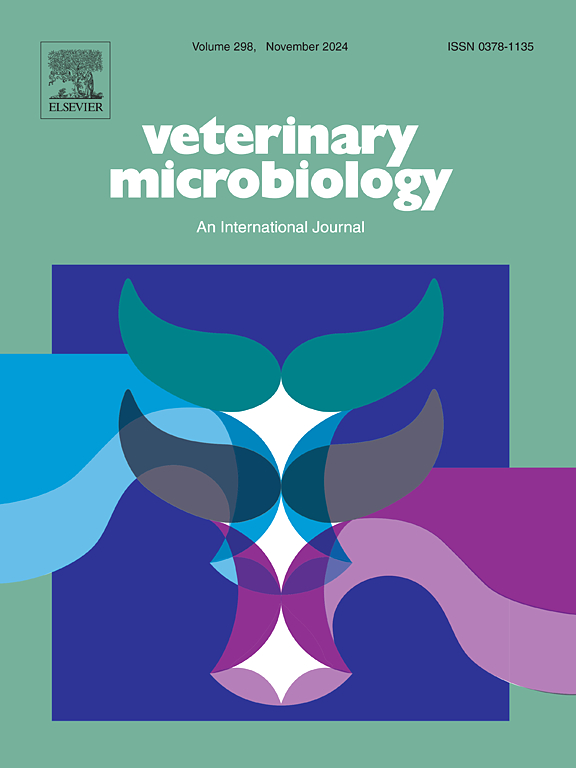Potential of recombinant CAV1-Fc in the treatment of ApxI toxin-induced damage by Actinobacillus pleuropneumoniae
IF 2.4
2区 农林科学
Q3 MICROBIOLOGY
引用次数: 0
Abstract
Currently, porcine contagious pleuropneumonia (PCP) caused by Actinobacillus pleuropneumoniae (APP), poses a significant threat to the pig breeding industry. There is an urgent need for effective therapeutic and prophylactic treatments, especially those that can overcome the limitations associated with vaccines and antibiotics. This includes the development of novel antitoxin agents, immunomodulatory therapies, and alternative strategies like phage therapy and herbal extracts. Our previous study has demonstrated membrane protein caveolin-1 (CAV1) is a key protein that acts as a functional receptor of APP ApxI toxin by binding to its acylated region. Here, we developed recombinant human N-CAV1-Fc fusion protein and C-CAV1-Fc fusion protein. Both fusion proteins could tightly bind to ApxI toxin. N-CAV1-Fc and C-CAV1-Fc fusion proteins efficiently blocked the interaction between ApxI toxin and immortalized porcine alveolar macrophages (iPAMs), thereby inhibiting cell apoptosis caused by APP ApxI toxin. Furthermore, prophylactic and therapeutic CAV1-Fc treatments effectively protected mice from ApxI toxin-induced damage, as determined by reduced weight loss, apoptosis factor transcription, and pathological changes in the lungs. The protective effects of N-CAV1-Fc and C-CAV1-Fc showed clear dose-dependent efficacy in vivo. Protein kinetics data indicated that N-CAV1-Fc has a relatively longer half-life in vivo compared to C-CAV1-Fc, making it an excellent candidate for prevention and treatment of APP infections.
重组CAV1-Fc治疗胸膜肺炎放线杆菌ApxI毒素损伤的潜力
目前,由胸膜肺炎放线杆菌(APP)引起的猪传染性胸膜肺炎(PCP)对养猪业构成了重大威胁。迫切需要有效的治疗和预防性治疗,特别是那些能够克服与疫苗和抗生素有关的局限性的治疗。这包括开发新的抗毒素药物、免疫调节疗法和替代策略,如噬菌体疗法和草药提取物。我们之前的研究表明,膜蛋白caveolin-1 (CAV1)是APP ApxI毒素的一个关键蛋白,通过结合其酰化区域作为其功能受体。本研究构建了重组人N-CAV1-Fc融合蛋白和C-CAV1-Fc融合蛋白。两种融合蛋白均能与ApxI毒素紧密结合。N-CAV1-Fc和C-CAV1-Fc融合蛋白有效阻断ApxI毒素与永活猪肺泡巨噬细胞(iPAMs)的相互作用,从而抑制APP ApxI毒素引起的细胞凋亡。此外,预防性和治疗性CAV1-Fc治疗可有效保护小鼠免受ApxI毒素诱导的损伤,这可以通过减轻体重、细胞凋亡因子转录和肺部病理变化来确定。N-CAV1-Fc和C-CAV1-Fc的体内保护作用表现出明显的剂量依赖性。蛋白质动力学数据表明,与C-CAV1-Fc相比,N-CAV1-Fc在体内具有相对较长的半衰期,使其成为预防和治疗APP感染的优秀候选者。
本文章由计算机程序翻译,如有差异,请以英文原文为准。
求助全文
约1分钟内获得全文
求助全文
来源期刊

Veterinary microbiology
农林科学-兽医学
CiteScore
5.90
自引率
6.10%
发文量
221
审稿时长
52 days
期刊介绍:
Veterinary Microbiology is concerned with microbial (bacterial, fungal, viral) diseases of domesticated vertebrate animals (livestock, companion animals, fur-bearing animals, game, poultry, fish) that supply food, other useful products or companionship. In addition, Microbial diseases of wild animals living in captivity, or as members of the feral fauna will also be considered if the infections are of interest because of their interrelation with humans (zoonoses) and/or domestic animals. Studies of antimicrobial resistance are also included, provided that the results represent a substantial advance in knowledge. Authors are strongly encouraged to read - prior to submission - the Editorials (''Scope or cope'' and ''Scope or cope II'') published previously in the journal. The Editors reserve the right to suggest submission to another journal for those papers which they feel would be more appropriate for consideration by that journal.
Original research papers of high quality and novelty on aspects of control, host response, molecular biology, pathogenesis, prevention, and treatment of microbial diseases of animals are published. Papers dealing primarily with immunology, epidemiology, molecular biology and antiviral or microbial agents will only be considered if they demonstrate a clear impact on a disease. Papers focusing solely on diagnostic techniques (such as another PCR protocol or ELISA) will not be published - focus should be on a microorganism and not on a particular technique. Papers only reporting microbial sequences, transcriptomics data, or proteomics data will not be considered unless the results represent a substantial advance in knowledge.
Drug trial papers will be considered if they have general application or significance. Papers on the identification of microorganisms will also be considered, but detailed taxonomic studies do not fall within the scope of the journal. Case reports will not be published, unless they have general application or contain novel aspects. Papers of geographically limited interest, which repeat what had been established elsewhere will not be considered. The readership of the journal is global.
 求助内容:
求助内容: 应助结果提醒方式:
应助结果提醒方式:


